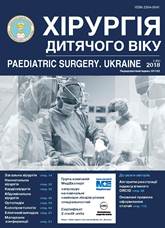Complications of postoperative intraabdominal infiltrates in children
DOI:
https://doi.org/10.15574/PS.2018.59.55Keywords:
children, postoperative intraabdominal infiltrates, complications, abscessingAbstract
Introduction. Despite the application of modern diagnostic techniques and treatment of acute diseases of the abdominal cavity organs, the problem of postoperative complications for appendicular peritonitis remains relevant, and varies from 12.4 to 48.6 %.Objective: to increase the treatment efficiency of children with postoperative intraabdominal infiltrates and to prevent their complications.
Materials and methods. In total 186 children were under observation with postoperative intraabdominal infiltrates (PIA). The key efficiency indicators of the proposed comprehensive treatment were the absence or reduction of PIA complications, namely: abscessing of intraabdominal infiltrate and early adhesive intestinal obstruction.
Results. It was found that statistically suppuration of the postoperative wound was 4.2 times less in the comparison groups; the early adhesion obstruction rate appeared 3.3 times lower as well as abscessing of intraabdominal infiltrates – 7.3 times lower than in the control group.
Conclusion. The number of complications depends on the primary method of intervention: among the children of the control group, there were 1.7 times more complications observed during the initial laparotomy as compared to laparoscopy; in children from the comparison group for minimally invasive interventions, the complications appeared 2 times less often than in children with open laparotomy.
References
Mryihin GA, Cherkasov MF, Groshilin VS. (2012). Analiz effektivnosti profilaktiki gnoyno-septicheskih oslozhneniy u bolnyih posle otkryitoy i laparoskopicheskoy appendektomii. Voenno-meditsinskiy zhurnal. 33(4): 65-67.
Sazhin AV, Mosin SV, Kodzhoglyan AA, Medoev VV, Mirzoyan AT, Yuldoshev AR i dr. (2012). Minimizatsiya dostupa v hirurgii ostrogo appenditsita i ego osloneniy. Hirurgiya Zhurnal imeni NI Pirogova. 6: 65-72.
Shatobalov VK. (2013). Appenditsit: etiologiya, patogenez, klassifikatsiya, a takzhe variantyi ego retsidiviruyuschego i hronicheskogo techeniya. Hirurgiya Zhurnal imeni NI Pirogova. 4: 87-91.
Cheng Y, Zhou S, Zhou R, Lu J, Wu S, Xiong X et al. (2015). Abdominal drainage to prevent intra-peritoneal abscess after open appendectomy for complicated appendicitis. Cochrane Database of Systematic Reviews. 2: 39. http://www.thecochranelibrary.com. https://doi.org/10.1002/14651858.CD010168.pub2.
Emil S, Elkady S, Shbat L, Youssef F, Baird R, Laberge JM et al. (2014). Determinants of postoperative abscess occurrence and percutaneous drainage in children with perforated appendicitis. Pediatric Surgery International. 30(12): 1265-71. https://doi.org/10.1007/s00383-014-3617-4. Epub 2014 Nov 2.
Holcomb III GW, St. Peter SD. (2012). Current management of complicated appendicitis in children. European Journal of Pediatric Surgery. 22(3): 207-12. https://doi.org/10.1055/s-0032-1320016. Epub 2012 Jul 5.
Raines A, Garwe T, Wicks R, Palmer M, Wood F, Adeseye A et al. (2013). Pediatric appendicitis: The prevalence of systemic inflammatory response syndrome upon presentation and its association with clinical outcomes. Pediatric Surgery. 48(12): 2442-5. https://doi.org/10.1016/j.jpedsurg.2013.08.017.
Slusher J, Bates CA, Johnson C. (2014). Standardization and improvement of care for pediatric patients with perforated appendicitis. Pediatric Surgery. 49(6): 1020-25. https://doi.org/10.1016/j.jpedsurg.2014.01.045.
Downloads
Issue
Section
License
The policy of the Journal “PAEDIATRIC SURGERY. UKRAINE” is compatible with the vast majority of funders' of open access and self-archiving policies. The journal provides immediate open access route being convinced that everyone – not only scientists - can benefit from research results, and publishes articles exclusively under open access distribution, with a Creative Commons Attribution-Noncommercial 4.0 international license(СС BY-NC).
Authors transfer the copyright to the Journal “PAEDIATRIC SURGERY.UKRAINE” when the manuscript is accepted for publication. Authors declare that this manuscript has not been published nor is under simultaneous consideration for publication elsewhere. After publication, the articles become freely available on-line to the public.
Readers have the right to use, distribute, and reproduce articles in any medium, provided the articles and the journal are properly cited.
The use of published materials for commercial purposes is strongly prohibited.

